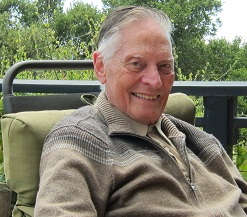Biography:Geoffrey Chew
Geoffrey F. Chew | |
|---|---|
 Chew at his California home on July 2014 | |
| Born | June 5, 1924 Washington, D.C., United States |
| Died | April 12, 2019 (aged 94) Berkeley, California, United States |
| Alma mater | University of Chicago |
| Known for | S-matrix theory, bootstrap theory, strong interactions, Chew–Frautschi plot |
| Awards | Hughes Prize (1962) Lawrence Prize (1969) Majorana Prize (2008) |
| Scientific career | |
| Fields | Theoretical physics |
| Institutions | University of Illinois UC Berkeley |
| Doctoral advisor | Enrico Fermi |
| Doctoral students | David Gross Freda Friedman Salzman John H. Schwarz John R. Taylor |
Geoffrey Foucar Chew (/tʃuː/; June 5, 1924 – April 12, 2019)[1][2] was an American theoretical physicist. He is known for his bootstrap theory of strong interactions.[3]
Life
Chew worked as a professor of physics at the UC Berkeley since 1957 and was an emeritus since 1991. Chew held a PhD in theoretical particle physics (1944–1946) from the University of Chicago. Between 1950 and 1956, he was a physics faculty member at the University of Illinois. In addition, Chew was a member of the National Academy of Sciences as well as the American Academy of Arts and Sciences.[4] He was also a founding member of the International Center for Transdisciplinary Research (CIRET).
Chew was a student of Enrico Fermi. His students include David Gross, one of the winners of the 2004 Nobel Prize in Physics, and John H. Schwarz, one of the pioneers of string theory.
Work
Chew was known as a leader of the S-matrix approach to the strong interaction and the associated bootstrap principle, a theory whose popularity peaked in the 1960s when he led an influential theory group at the University of California, Berkeley. S-matrix theorists sought to understand the strong interaction by using the analytic properties of the scattering matrix to calculate the interactions of bound-states without assuming that there is a point-particle field theory underneath. The S-matrix approach did not provide a local space-time description. Although it was not immediately appreciated by the practitioners, it was a natural framework in which to produce a quantum theory of gravity.
Chew's central contribution to the program came in 1961:[5] along with collaborator Steven Frautschi, they noted that the mesons fall into families (straight-line Regge trajectories) where the square of the mass of a meson is linearly proportional to the spin (in their scheme, spin is plotted against mass squared on a so-called Chew–Frautschi plot), with the same constant of proportionality for each of the families. Since bound states in quantum mechanics naturally fall into families of this sort, their conclusion, quickly accepted, was that none of the strongly interacting particles were elementary. The conservative point of view was that the bound states were made up of elementary particles, but Chew's more far-reaching vision was that there would be a new type of theory which describes the interactions of bound-states which have no point-like constituents at all. This approach was sometimes called nuclear democracy, since it avoided singling out certain particles as elementary.
Legacy
Although the S-matrix approach to the strong interactions was largely abandoned by the particle physics community in the 1970s in favor of quantum chromodynamics, a consistent theory for the scattering of bound-states on straight-line trajectories was eventually constructed and is nowadays known as string theory. Within string theory, Edward Witten reinterpreted S-matrix theory as a flat-space statement of the holographic principle.
Professor Chew participated in religion and science discussions. He stated that an "appeal to God may be needed to answer the 'origin' question, 'Why should a quantum universe evolving toward a semiclassical limit be consistent?'" [6]
Chew investigated into models in which the concept of happenings or (pre-)events play a fundamental role, not only particles.[clarification needed] He saw similarities among his approach and the notion of occasion of Alfred North Whitehead.[7]
Awards
Chew received the Hughes Prize of the American Physics Society for his bootstrap theory of strong interactions in 1962. He also won the Lawrence Prize in 1969[4] and Majorana Prize in 2008.
References
- ↑ U.S. Public Records Index Vol 1 (Provo, UT: Ancestry.com Operations, Inc.), 2010.
- ↑ "Remembering Geoffrey Chew". https://physics.berkeley.edu/news-events/news/20190415/remembering-geoffrey-chew. Retrieved April 18, 2019.
- ↑ Basarab Nicolescu, "The Bootstrap Principle and the Uniqueness of our World", in From Modernity to Cosmodernity - Science, Culture, and Spirituality, SUNY Press, 2018
- ↑ 4.0 4.1 Faculty: Geoffrey F. Chew, Physics at Berkeley, Department of Physics University of California (accessed April 2, 2012)
- ↑ Chew, Geoffrey; Frautschi, S. (1961). "Principle of Equivalence for all Strongly Interacting Particles within the S-Matrix Framework". Physical Review Letters 7 (10): 394–397. doi:10.1103/PhysRevLett.7.394. Bibcode: 1961PhRvL...7..394C. https://core.ac.uk/download/4872313.pdf.
- ↑ pages 33-36 of Margenau, H. (1992). Cosmos, Bios, Theos: Scientists Reflect on Science, God, and the Origins of the Universe, Life, and Homo sapiens. Open Court Publishing Company. co-edited with Roy Abraham Varghese. This book is mentioned in a December 28, 1992, Time (magazine) article: Galileo And Other Faithful Scientists
- ↑ Physics and Whitehead Workshop , August 5–6, 1998
External links
- 2016 Video Interview with Geoffrey Chew by the Atomic Heritage Foundation Voices of the Manhattan Project
 |

